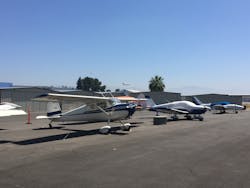For managers of general aviation airports across the nation, the definition of sustainability is as diverse as the stakeholders whom they serve. However, most contend that maintaining both economic viability and social responsibility are vital to maintaining a healthy airport.
The Airport Cooperative Research Program (ACRP), which is funded by the Federal Aviation Administration (FAA) and undertakes research in a variety of aviation subject areas, defines airport sustainability as practices that ensure:
- Protection of the environment, including conservation of natural resources
- Social progress that recognizes the needs of all stakeholders
- Maintenance of high and stable levels of economic growth and employment
There is no simple formula for achieving airport sustainability, as each facility has a unique operating environment, business structure, governance and market. In addition, airport management face diverse challenges in relation to meeting user needs in the areas of maintenance, modernization, budgeting, security, grant assurances, and local political and community initiatives.
This discussion is designed to encourage visionary thinking from airport, business and community leaders, as well as airport users, on how to collaboratively achieve a robust airport that supports both economic development and public access to aviation.
Navigating the Path to Self-Sufficiency
When it comes to maintaining the economic health of an airport, it is crucial to understand its unique operating environment. In broad terms, general aviation airports must comply with a host of federal regulations and requirements, while navigating local market forces and economic and environmental pressures.
General aviation airports traditionally generate revenue from lease rates, fees and charges collected from tenants and users who provide a broad range of aeronautical services to the aviation community including: aircraft sales and acquisitions, fuel, aircraft ground support, passenger and crew services, aircraft parking and storage, on-demand air charter, aircraft rental, flight training, aircraft maintenance and overhaul facilities, parts sales, and business aircraft and fractional ownership fleet management.
Development at general aviation airports often takes the shape of public-private partnerships, modeling the discussions currently underway at the nation’s commercial service airports. For example, an airport sponsor enters into a type of public-private partnership with a fixed based operator (FBO) that provides airport users with a wide range of aeronautical services. In return, the airport sponsor receives a fee for the land and the community receives the economic benefit, with minimal risk for the business enterprise that is created. An increased number of airports are also entering into agreements with private companies that provide renewable energy sources, such as solar panel installations, that can diversify revenue streams, significantly reduce energy costs and benefit the environment.
A third revenue stream at airports comes from specialty companies that serve aviation-related segments of the economy. Corporate and general aviation services are augmented by a diverse array of mixed-use facilities, including business parks and industrial centers, which make airports a powerful economic engine.
Finally, public-use airports benefit from grants provided by the FAA for vital infrastructure projects. Eligibility for these Airport Improvement (AIP) funds is specifically based on the airport’s ability to maintain a level and competitive playing field for leaseholders engaged in aeronautical activities. To maintain its grant assurances, airport sponsors are responsible for ensuring that its tenants provide services at prices that are fair, reasonable and non-discriminatory.
Competition, Not Regulation, Creates Healthy Airports
At some general aviation airports, as well as commercial airports with general aviation facilities, corporate aviation accounts for a disproportionate share of revenue generated compared to smaller general aviation aircraft. How then, do airports achieve economic sustainability while maintaining a healthy mix of jet, propeller and helicopter operations?
A proper mix of operations and aircraft cannot be achieved through increased federal regulation or market manipulation. Rather, airports must aggressively work to implement policies that maintain balance among the needs of diverse airport users, while extending the benefits of aviation to the local community.
This includes using a competitive selection process to attract tenants that make significant capital investment and offer quality services at reasonable prices. Airport sponsors must also establish fair and equitable lease rates and charges appropriate to the local market, as well as address mixed land use in their long-term master and business plans. When airport operators view their tenants as true business partners, they achieve mutual success and advance the airport’s mission to achieve both economic and social sustainability.
Case Study - The Airport Sponsor/Tenant Relationship
Currently, the Aircraft Owners and Pilots Association is calling for the FAA to regulate the price of aeronautical services provided by FBOs, such as fuel and ramp fees, to achieve unfettered airport access. While this suggests that private pilots would receive the lowest costs available, it actually constrains the airport’s ability to serve the aviation community and achieve its goals.
The investments made by aviation and FBO facilities not only serve local pilots, but are gateways to economic investment in the community. As leases come up for renewal, an increased number of airports are requiring FBOs to make significant capital investments which revert back to the sponsor at the end of the ground lease. Each airport and each market is different. Thus, based on local and regional knowledge, FBOs construct pricing that enables them to provide quality service at a reasonable rate of return.
The economics of airport business place great importance on master lease terms and available revenue streams to create viable airports. While FBOs frequently comply with guaranteed service levels and facilities dictated by airport minimum standards, their business model does not guarantee income. Sparing airports the risks of an open and volatile market, they provide a steady revenue stream in the form of rent. Ultimately, the rates and charges collected by the airport sponsor are reinvested to help create a healthier airport.
In circumstances where pilots feel they do not have access to the best prices for fuel and other FBO services, the situation is best mitigated locally through the airport sponsor, which is obligated by federal law to ensure access on fair and reasonable terms. This does not equate to the lowest prices, but does require FBOs to offer equal rates to similarly-situated pilots. If the situation is not resolved, a last resort is the formal FAA Part 13 or 16 complaint process.
Clearly, this does not remove responsibility for the fair and equal treatment of pilots and other airport users from the realm of the airport sponsor. Rather, airports are held accountable for supporting policies and programs that best serve the diverse needs of the entire aviation community.
At Van Nuys Airport, for instance, progress on a 30-acre development project dedicated to propeller aircraft is climbing full speed ahead. This site, still under construction, provides hangars, tie-downs and office facilities for up to 270 propeller aircraft and related businesses. It also features a self-serve fueling station for private pilots. By relocating approximately 85 portable hangars from other leaseholds, this facility enabled other development projects to move forward and generate substantial economic impact.
Practices to Achieve Economic Sustainability
Creating an environment where airport businesses can thrive provides benefits to airport sponsors, users and operators, while creating high-skilled, high-paying jobs in the community. A business-friendly environment also attracts public-private partnerships to the airport, including those that advance green technology and neighborhood compatibility.
The following are a few practices that can help propel an airport toward economic health and, in so doing, promote policies that are both responsive to business and responsible to the community:
- Develop and enforce airport minimum standards that promote the highest levels of safety, security and service for all airport users.
- Ensure the airport has a current business/redevelopment plan and schedule of rates and charges that reflect its overall vision and mission.
- Consider a transparent RFP process to solicit business proposals for real estate that is designated for both aeronautical and FAA approved non-aeronautical uses.
- Review and maintain compliance with all airport grant assurances and regulatory measures established by federal, state and local government agencies with jurisdiction over the airport and its users.
- Think globally, but work locally with airport users and operators, public officials and prominent business, civic and community organizations to form an airport business support team.
Finally, aviation industry leaders and policymakers should take advantage of organizations throughout the world, such as ACRP, that contribute guidance and research on subjects of importance to airports. Many of their findings derive from the day-to-day challenges faced by airport managers and can lead to innovative solutions.
Curt Castagna, president and CEO of Aeroplex/Aerolease Group, is a member of the Los Angeles County Airport Commission, president of the Van Nuys and Long Beach Airport Associations, and a board member of the National Air Transportation Association. A certified private and instrument-rated pilot, he has instructed courses in aviation administration at Cal State Los Angeles for over two decades.




